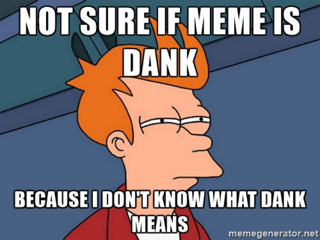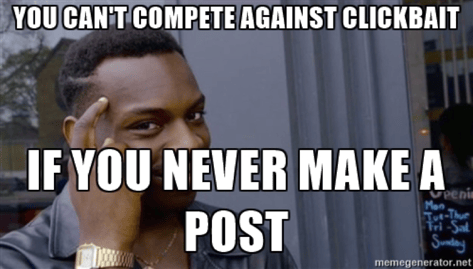
Only here will you get the truth and the full story!
Well, you fell for it again. An obvious clickbait headline and you still clicked on it. Maybe you are genuinely interested in how to compete in a Facebook feed full of clickbait? Maybe you were just curious as to what conspiracy would be cooked up in this article (by the way, if your posts are not getting shared and reaching people it is because of the government).
In a world of “fake news” and clickbait headlines it might seem impossible to get people’s attention with Social Media posts. Christians are constrained by the 8th Commandment (or 9th for my Evangelical friends). You know, the one where we do not give false testimony. Or, as parents eloquently sum up the world over: “Don’t lie.”
Clickbait plays to our basest of instincts. We want the bad things about our “enemies” to be true. So, when we see headlines about secret coups, bad Android phones, aliens from Mars infiltrating all levels of government (I am looking at you, postman. I saw Men in Black!) we click on them often knowing that the facts in the story are at best wildly misconstrued and at worst completely made up. These stories get clicked on and shared before anybody does any sort of fact checking. And, before the truth even gets out of bed a lie is halfway around the world.
There is some relief on the way. Facebook has rolled out a feature where people can flag an article as “disputed”. Said article will then be fact-checked by a neutral third party. If it is indeed “fake news” (not the *wink, wink* kind) then Facebook’s algorithms will push it down on news feeds and it will not be seen as easily or as much. Hopefully this will decrease the competition for getting people’s attention.
With that introduction, let us dive in. How do you compete in a clickbait world?
1. Dank Memes
When it comes to memes, only the dankest will suffice.

In all seriousness, however, a great visual helps to draw attention. Pictures attract the eye, especially when they are competing against text. Placing an appropriate picture in a post helps it to stand out. It draws the eye and captures the reader’s attention.
2. K.I.S.
Unlike the K.I.S.S. many people are familiar with, this K.I.S. is shorter by one “s”. K.I.S. stands for “keep it short.” Posts do not need a novella’s worth of writing and information. Shorter is better. Attention spans are short. If people see that they have to read a lot they are more likely to just skip over it. Instead, the post should direct to a place that has more information.
Think of the Social Media post as a descriptor or teaser. All you want is to pique people’s interest. Trying to tell them everything all at once is counterproductive. This is why newspapers use headlines. And, it brings us to our next tip.
3. Use Links
Links on Facebook or Twitter are great! Are you posting great stuff on your blog? Want to draw attention to your website's events page? Try using a link. Links are most effective when combined with a photograph or graphic. Just remember to keep the description short, sweet, and to the point. For example:
The description/teaser is 19 words.
On Twitter, where you only get 140 characters, CTS cut it down to 13 words.
Notice the picture (Dank Memes). It immediately grabs your attention. Your eye then goes up to read the description/teaser. You do not have to click on a “read more” button, the information is to the point (K.I.S.). You can then click on the link to read the full article. The link pulls in information adding to the teaser without detracting from the overall post.
4. Post Regularly
Facebook’s algorithm is an opaque mystery on a moonless night in a basement with no lights and you are wearing sunglasses. Nobody outside of Facebook actually knows how it works. It is supposed to highlight the few hundred stories and status updates (out of the thousands upon thousands) that you would find most interesting. And, according to Facebook’s own research and admission it works: “sometimes.” So, Facebook is always tinkering with the formula. Other Social Media websites adhere to a strict chronological order (Twitter). Or most popular, or a combination.
How to get noticed with a chronological order is to have posts go out at different times of the day, even duplicating posts if need be.
But, when it comes to Facebook one thing that helps is to regularly post. The trick is to finding the sweet spot of just enough. You are looking for the porridge that is not too hot or too cold, but just right. The chair that is not too big or too small, but just right. The bed that is... Okay, okay, Goldilocks, you get the point. You do not want to over saturate or under saturate. Depending on help (volunteered or hired) this might mean three or four times a week to a couple times a day.

There is some debate about whether to post during peak hours or off-peak hours. Honestly, I have seen so many articles arguing back and forth that I have come to the conclusion that whatever works for you, go with it. Do posts that go up on peak hours get more interaction and reach? Or, is it posts that happen in off hours? Again, part of this I imagine is the ever-changing formula of Facebook’s algorithm.
5. All the Feels
I pointed this out in another blog post, but stories that have a high emotional content get shared, liked, and otherwise reacted to, more than plain-Jane information ones. It makes sense: an emotional reaction is going to cause people to want to engage more.
Consistently, some of my church’s top posts are funeral announcements. Funerals are inherently sad, they elicit an emotional reaction. Both community and church members often know the deceased. This means the announcement will get shared not just among church members but among the community and even far away cities. Sometimes my church, which worships around 200, will reach more than 1,000 people organically with just a simple funeral announcement.
Now, before you start to bemoan that there are not a lot of deaths in your congregation let me point out that this is just an example. Sharing or creating content that has an emotional component should be the goal here. On the other hand, content creators should be careful to not just be pandering to emotions. It is a fine and delicate line to try and straddle.
Creating and sharing stories, whether in print or video, can find this balance. There are a myriad of ways to create stories. You can solicit members to volunteer to be interviewed. Interview topics can be across the board: “What drew you to ______________?” “How has doing family devotions helped your family?” “What did you see when you volunteered to help with VBS?” Those are just a few examples. You can create compelling and Christ-centered material from that or some other idea.
For more on making stories check out Katy Munson’s posts: Beginner’s Guide to Storytelling and Christ-Focused Storytelling. A carefully crafted message can help a post get shared more than one just thrown together or without coherency.
6. Dumb Luck
I know many people will not want to admit this, but sometimes things just get noticed more by plain luck than a carefully crafted message. This is not to denigrate a polished post. However, sometimes you post things thinking it will only attract your more hard-core followers and the next thing you know it has been shared over a hundred times. This is not the same as the above. You can count on personal, heartfelt posts (i.e. funeral announcements) to have wide-ranging engagement. Those posts often cross denominational and even geographic boundaries.
When it comes to dumb luck, sometimes it is a timing issue. I remember writing a Facebook post over Maundy Thursday. It simply stated that we should love each other as Christ loved us. It went up an hour before the Supreme Court ruled on something dealing with marriage circa March 2013. No idea the SCOTUS was going to do anything landmark that day, but they did. That post, which had nothing to do with marriage, but dealing with the mandate “to love one another as Christ has love us,” was one of the top-reaching posts I have ever written. And, I am 99% sure that over two-thirds of the people who read it misunderstood what it was originally about. There was nothing I could do about that.
There can be a myriad of other factors, but sometimes there is just a coincidence between the cultural zeitgeist and whatever you might be posting about. It is not a bad thing. Nor is it something to be counted on. I basically reran the same post a year later and it barely got a blip.
Conclusion
It can be frustrating trying to come up with content or write posts that engage people when it feels like one hand is tied behind our back. It does not seem fair that we must compete in the same space with groups or organizations that only care about advertisement revenue and so will write anything knowing it to be false because they know people will click on it. It can be depressing to learn about teenagers making thousands of dollars a month peddling lies while we struggle to reach a hundred people with an eternal life-saving message.
But, all is not lost. The truth will win out, I firmly believe that. And, there are ways (like the 1 thru 5 above) to make our posts more likely to reach people. We should not shrink from the public space of the internet. Nor should we stoop to the tactics of the enemy, namely lying (also, please ignore the blog post title).
Learn more about the use of technology in your church by subscribing to this blog!


























